Do you have a question about the MELAG Vacuklav 44 B+ Evolution and is the answer not in the manual?
Explains the meaning of symbols used in the manual and on the device.
Details the formatting conventions used within this document.
Description of the MELAconnect app functions and connectivity.
Instructions for the proper disposal of the device and accessories.
Ensures only competent personnel operate the device.
Safety precautions for device setup and initial operation.
Guidelines for safe handling of the power cable and plug.
Ensures the proper function of the spring safety valve.
Safety compliance for instrument reprocessing and sterilization.
Safety considerations when aborting a sterilization program.
Safety steps for safely removing sterilized materials.
Safety instructions for transporting and storing the device.
Safety guidelines for performing maintenance tasks.
Safety warnings concerning device repair by unauthorized personnel.
Information on handling device malfunctions and error messages.
Procedure for reporting serious accidents involving the medical product.
Defines the primary applications and scope of the steam sterilizer.
Details the fractionated vacuum procedure used for sterilization.
Specifies the requirements for feed water quality and supply.
Describes the integrated safety monitoring systems of the device.
Explains the automatic door locking and pressure compensation system.
Table detailing performance compliance with EN 13060 standards.
Description of the three main phases of a sterilization program.
Detailed breakdown of standard program steps.
Steps involved in performing the vacuum test.
Lists all items included in the standard delivery package.
Detailed list of components provided with the device.
Diagrams identifying all external parts and connections of the device.
Explanation of the various symbols and their meanings found on the device.
Information on how to correctly install and use load mounts.
Functionality of the energy-saving key and its operation.
Overview of the user interface and its main display areas.
Meaning of icons displayed in the status bar on the touch display.
Icons used within the device's menu system.
Icons representing available actions in the device interface.
Explanation of LED colors indicating device status.
Instructions and requirements for initial device setup and installation.
Details on connecting and supplying feed water to the sterilizer.
Guidance on using an external water storage container.
Information on connecting and using a water treatment unit.
Requirements and connection details for the cooling water supply.
Step-by-step guide to powering on the steam sterilizer.
Procedure for safely opening and closing the sterilizer door.
Procedure for manually opening the door in emergency situations.
Continued instructions for manual door emergency opening.
General guidelines for preparing instruments and textiles for sterilization.
Detailed steps for cleaning and preparing instruments.
Specific instructions for reprocessing and preparing textiles.
Best practices for loading the sterilization chamber correctly.
Information on suitable packaging materials for sterilization.
Guidelines for using closed sterilization containers effectively.
Instructions for using soft sterilization packaging materials.
Guidance on performing multiple wrapping techniques.
Recommendations for sterilizing mixed loads of different items.
Key recommendations for daily and weekly operational checks.
Specific recommendations for type B sterilizer routine checks.
Guide to choosing the appropriate sterilization program for different loads.
Overview of optional programs like Vacuum test and Bowie & Dick test.
Details on features like additional drying and start time pre-selection.
Instructions for scheduling program start times.
Steps to initiate a sterilization program and handle user authentication.
Description of program phases and monitoring progress.
How to monitor program progress remotely via a web browser.
Procedure for manually stopping a running program.
Safety and procedure for aborting before the drying phase.
Procedure and considerations for aborting after the drying phase has begun.
Steps to take when a program completes successfully.
Explanation of the batch approval process and user authentication.
Safe procedures for unloading the sterilized load.
Guidelines for the proper storage of sterilized materials.
How to obtain and archive batch data for quality assurance.
Information on the device's internal memory capacity for logs.
Available options for outputting and archiving sterilization logs.
Instructions for using a CF card to save log data.
Connecting the device to a computer for log transfer.
Steps to access and view log files on a computer.
How to use a label printer for batch traceability.
Setting up automatic log output upon program completion.
Options for outputting logs manually after program completion.
Procedure for selecting and outputting specific logs.
Methods for outputting logs based on date ranges.
Information on locating log files on storage media.
Details on where log files are stored after output.
Explanation of the directory structure for log files.
A sample log entry illustrating data format and content.
Performing manual checks to verify device functions.
Procedure for conducting a vacuum test to check for leakages.
Instructions for performing the Bowie & Dick steam penetration test.
How to interpret the results of the Bowie & Dick test indicator.
Configuration options related to log output and management.
Settings to enable or disable automatic log output.
Steps to turn off automatic log output.
Settings for enabling optional graphic log output.
Further configuration for graphic log output.
Setting the language for log printer output.
Configuring the computer as a log output destination.
Steps to establish an FTP connection for data transfer.
Steps to establish a TCP connection for data transfer.
Information on device IP address configuration.
Details on setting device IP addresses within a network.
Options for customizing the format of logged data.
Managing user accounts and PINs for access control.
Procedure for creating new user accounts.
Continuation of instructions for adding users.
Steps to remove existing user accounts.
Instructions for changing the administrator's PIN.
Configuring user authentication requirements for programs.
Setting up program start and batch approval authentication.
Steps to format the CF card, erasing all data.
How to activate or deactivate additional drying for programs.
Setting additional drying globally.
Enabling additional drying for a single program.
Configuring the intelligent drying feature for optimized drying cycles.
Instructions for setting the device's date and time.
Adjusting the display brightness and contrast.
Setting the audio volume for device feedback.
Options for selecting the user interface display mode.
Changing the display theme from modern to classic.
Changing the display theme from classic to modern.
Connecting the device to the MELAconnect mobile application.
Enabling or disabling audible feedback for button presses.
Activating and configuring the device's screensaver.
Setting display duration and waiting time for the screensaver.
Configuration for using the MELAprint 42/44 log printer.
Configuration for using the MELAprint 60 label printer.
Adjusting the touchscreen sensitivity.
Configuring energy-saving modes and waiting times.
Setting the display to automatically switch off when inactive.
Schedule and measures for routine device maintenance.
General instructions for cleaning the device surfaces.
Specific cleaning procedures for key internal components.
Cleaning instructions for the external housing.
Checks and cleaning procedures for the water storage container.
Measures to prevent staining on instruments and the device.
Routine checks and lubrication for the door lock mechanism.
Overall guidance on performing regular maintenance and its importance.
Considerations for pause times between sterilization cycles.
Measures to take based on the length of an operating pause.
Steps for preparing the device for extended periods of non-use.
Procedure for draining the steam generator's double jacket.
General safety precautions for moving the device.
Guidelines for safely moving the device within a facility.
Procedures for preparing the device for shipping or long-distance transport.
Steps for setting up the device after it has been moved.
Overview of different types of notifications displayed by the device.
Information on accessing online troubleshooting resources.
Preparatory steps before contacting customer service for support.
How to view malfunction messages via the MELAconnect app.
List of specific warning and error messages with causes and solutions.
Continuation of error message list and troubleshooting steps.
Further error messages and their corresponding solutions.
Additional error codes and troubleshooting guidance.
More error messages and their resolutions.
Extended list of malfunction messages and troubleshooting advice.
Further error messages and troubleshooting steps.
Continued troubleshooting for various error codes.
Additional malfunction messages and solutions.
More error conditions and their resolution steps.
Final set of error messages and troubleshooting guidance.
Specifications for Vacuklav 40 B+ and 44 B+ models.
Physical dimensions of the steam sterilizer.
Details on the chamber's diameter, depth, and volume.
Power supply requirements and fuse ratings.
Environmental operating parameters like noise and temperature.
Specifications for the cooling water supply.
Requirements for the feed water supply.
Details on the wastewater discharge connection.
Types of mounts available for trays and MELAstore boxes.
Different tray models and their specifications.
List of sterilization containers and their compliance.
Information on the MELAstore system for load storage.
Details on test body systems for performance checks.
Available water treatment units for feed water.
Accessories related to device documentation and data transfer.
Miscellaneous accessories not fitting other categories.
Specific spare parts for the device, including part numbers.
Definition of air leakage and its significance in sterilization.
Abbreviation for 'Arbeitskreis Instrumentenaufbereitung'.
Definition of a technician authorized by MELAG.
Definition of a batch in the context of reprocessing.
Explanation of the Bowie & Dick test for steam penetration.
Description of the CF card as a memory medium.
Definition of personnel qualified for specific tasks.
Definition of fluid produced by cooling and separation.
Definition of the ability of a substance to conduct energy.
Definition of chemical alteration of metal materials.
Explanation of the phenomenon of superheating fluids.
Definition of demineralized water and its use.
Abbreviation for 'Deutsche Gesellschaft für Sterilgutverordnung'.
Reference to German statutory accident insurance regulations.
Standard for steam sterilizers in healthcare.
Standard for sterilization and sterile equipment supply.
Definition of distilled water and its applications.
Explanation of the steam generator's function.
Purpose of the dynamic pressure test.
Description of the empty chamber test procedure.
Standard for small steam sterilizers.
Explanation of crossover network cables.
Standard for non-biological systems and test bodies.
Definition of porous materials.
Standard for sterilization of products using chemical indicators.
Explanation of the porous full load test.
Standard for sterile barrier systems and packaging.
Explanation of the porous partial load test.
Definition of creating a vacuum.
Explanation of the device's self-monitoring system.
Definition and purpose of feed water.
Definition of products with narrow lumens.
Description of the fractionated vacuum sterilization technique.
Definition of a qualified electrician.
Definition of File Transfer Protocol.
Abbreviation for Robert Koch Institute.
Time required for the steam sterilizer to reach operating temperature.
Definition of simple hollow body articles.
Definition of items processed in one cycle.
Definition of single wrapping technique.
Definition of mixed loads.
Definition of soft sterilization packaging.
Definition of multiple wrapping.
Definition of solid items without gaps.
Explanation of the solid load test.
Definition of a sterile barrier system.
Definition of sterilized material.
Definition of the sterilizer's interior.
Definition of Transmission Control Protocol.
Definition of vacuum in technical terms.
Explains the meaning of symbols used in the manual and on the device.
Details the formatting conventions used within this document.
Description of the MELAconnect app functions and connectivity.
Instructions for the proper disposal of the device and accessories.
Ensures only competent personnel operate the device.
Safety precautions for device setup and initial operation.
Guidelines for safe handling of the power cable and plug.
Ensures the proper function of the spring safety valve.
Safety compliance for instrument reprocessing and sterilization.
Safety considerations when aborting a sterilization program.
Safety steps for safely removing sterilized materials.
Safety instructions for transporting and storing the device.
Safety guidelines for performing maintenance tasks.
Safety warnings concerning device repair by unauthorized personnel.
Information on handling device malfunctions and error messages.
Procedure for reporting serious accidents involving the medical product.
Defines the primary applications and scope of the steam sterilizer.
Details the fractionated vacuum procedure used for sterilization.
Specifies the requirements for feed water quality and supply.
Describes the integrated safety monitoring systems of the device.
Explains the automatic door locking and pressure compensation system.
Table detailing performance compliance with EN 13060 standards.
Description of the three main phases of a sterilization program.
Detailed breakdown of standard program steps.
Steps involved in performing the vacuum test.
Lists all items included in the standard delivery package.
Detailed list of components provided with the device.
Diagrams identifying all external parts and connections of the device.
Explanation of the various symbols and their meanings found on the device.
Information on how to correctly install and use load mounts.
Functionality of the energy-saving key and its operation.
Overview of the user interface and its main display areas.
Meaning of icons displayed in the status bar on the touch display.
Icons used within the device's menu system.
Icons representing available actions in the device interface.
Explanation of LED colors indicating device status.
Instructions and requirements for initial device setup and installation.
Details on connecting and supplying feed water to the sterilizer.
Guidance on using an external water storage container.
Information on connecting and using a water treatment unit.
Requirements and connection details for the cooling water supply.
Step-by-step guide to powering on the steam sterilizer.
Procedure for safely opening and closing the sterilizer door.
Procedure for manually opening the door in emergency situations.
Continued instructions for manual door emergency opening.
General guidelines for preparing instruments and textiles for sterilization.
Detailed steps for cleaning and preparing instruments.
Specific instructions for reprocessing and preparing textiles.
Best practices for loading the sterilization chamber correctly.
Information on suitable packaging materials for sterilization.
Guidelines for using closed sterilization containers effectively.
Instructions for using soft sterilization packaging materials.
Guidance on performing multiple wrapping techniques.
Recommendations for sterilizing mixed loads of different items.
Key recommendations for daily and weekly operational checks.
Specific recommendations for type B sterilizer routine checks.
Guide to choosing the appropriate sterilization program for different loads.
Overview of optional programs like Vacuum test and Bowie & Dick test.
Details on features like additional drying and start time pre-selection.
Instructions for scheduling program start times.
Steps to initiate a sterilization program and handle user authentication.
Description of program phases and monitoring progress.
How to monitor program progress remotely via a web browser.
Procedure for manually stopping a running program.
Safety and procedure for aborting before the drying phase.
Procedure and considerations for aborting after the drying phase has begun.
Steps to take when a program completes successfully.
Explanation of the batch approval process and user authentication.
Safe procedures for unloading the sterilized load.
Guidelines for the proper storage of sterilized materials.
How to obtain and archive batch data for quality assurance.
Information on the device's internal memory capacity for logs.
Available options for outputting and archiving sterilization logs.
Instructions for using a CF card to save log data.
Connecting the device to a computer for log transfer.
Steps to access and view log files on a computer.
How to use a label printer for batch traceability.
Setting up automatic log output upon program completion.
Options for outputting logs manually after program completion.
Procedure for selecting and outputting specific logs.
Methods for outputting logs based on date ranges.
Information on locating log files on storage media.
Details on where log files are stored after output.
Explanation of the directory structure for log files.
A sample log entry illustrating data format and content.
Performing manual checks to verify device functions.
Procedure for conducting a vacuum test to check for leakages.
Instructions for performing the Bowie & Dick steam penetration test.
How to interpret the results of the Bowie & Dick test indicator.
Configuration options related to log output and management.
Settings to enable or disable automatic log output.
Steps to turn off automatic log output.
Settings for enabling optional graphic log output.
Further configuration for graphic log output.
Setting the language for log printer output.
Configuring the computer as a log output destination.
Steps to establish an FTP connection for data transfer.
Steps to establish a TCP connection for data transfer.
Information on device IP address configuration.
Details on setting device IP addresses within a network.
Options for customizing the format of logged data.
Managing user accounts and PINs for access control.
Procedure for creating new user accounts.
Continuation of instructions for adding users.
Steps to remove existing user accounts.
Instructions for changing the administrator's PIN.
Configuring user authentication requirements for programs.
Setting up program start and batch approval authentication.
Steps to format the CF card, erasing all data.
How to activate or deactivate additional drying for programs.
Setting additional drying globally.
Enabling additional drying for a single program.
Configuring the intelligent drying feature for optimized drying cycles.
Instructions for setting the device's date and time.
Adjusting the display brightness and contrast.
Setting the audio volume for device feedback.
Options for selecting the user interface display mode.
Changing the display theme from modern to classic.
Changing the display theme from classic to modern.
Connecting the device to the MELAconnect mobile application.
Enabling or disabling audible feedback for button presses.
Activating and configuring the device's screensaver.
Setting display duration and waiting time for the screensaver.
Configuration for using the MELAprint 42/44 log printer.
Configuration for using the MELAprint 60 label printer.
Adjusting the touchscreen sensitivity.
Configuring energy-saving modes and waiting times.
Setting the display to automatically switch off when inactive.
Schedule and measures for routine device maintenance.
General instructions for cleaning the device surfaces.
Specific cleaning procedures for key internal components.
Cleaning instructions for the external housing.
Checks and cleaning procedures for the water storage container.
Measures to prevent staining on instruments and the device.
Routine checks and lubrication for the door lock mechanism.
Overall guidance on performing regular maintenance and its importance.
Considerations for pause times between sterilization cycles.
Measures to take based on the length of an operating pause.
Steps for preparing the device for extended periods of non-use.
Procedure for draining the steam generator's double jacket.
General safety precautions for moving the device.
Guidelines for safely moving the device within a facility.
Procedures for preparing the device for shipping or long-distance transport.
Steps for setting up the device after it has been moved.
Overview of different types of notifications displayed by the device.
Information on accessing online troubleshooting resources.
Preparatory steps before contacting customer service for support.
How to view malfunction messages via the MELAconnect app.
List of specific warning and error messages with causes and solutions.
Continuation of error message list and troubleshooting steps.
Further error messages and their corresponding solutions.
Additional error codes and troubleshooting guidance.
More error messages and their resolutions.
Extended list of malfunction messages and troubleshooting advice.
Further error messages and troubleshooting steps.
Continued troubleshooting for various error codes.
Additional malfunction messages and solutions.
More error conditions and their resolution steps.
Final set of error messages and troubleshooting guidance.
Specifications for Vacuklav 40 B+ and 44 B+ models.
Physical dimensions of the steam sterilizer.
Details on the chamber's diameter, depth, and volume.
Power supply requirements and fuse ratings.
Environmental operating parameters like noise and temperature.
Specifications for the cooling water supply.
Requirements for the feed water supply.
Details on the wastewater discharge connection.
Types of mounts available for trays and MELAstore boxes.
Different tray models and their specifications.
List of sterilization containers and their compliance.
Information on the MELAstore system for load storage.
Details on test body systems for performance checks.
Available water treatment units for feed water.
Accessories related to device documentation and data transfer.
Miscellaneous accessories not fitting other categories.
Specific spare parts for the device, including part numbers.
Definition of air leakage and its significance in sterilization.
Abbreviation for 'Arbeitskreis Instrumentenaufbereitung'.
Definition of a technician authorized by MELAG.
Definition of a batch in the context of reprocessing.
Explanation of the Bowie & Dick test for steam penetration.
Description of the CF card as a memory medium.
Definition of personnel qualified for specific tasks.
Definition of fluid produced by cooling and separation.
Definition of the ability of a substance to conduct energy.
Definition of chemical alteration of metal materials.
Explanation of the phenomenon of superheating fluids.
Definition of demineralized water and its use.
Abbreviation for 'Deutsche Gesellschaft für Sterilgutverordnung'.
Reference to German statutory accident insurance regulations.
Standard for steam sterilizers in healthcare.
Standard for sterilization and sterile equipment supply.
Definition of distilled water and its applications.
Explanation of the steam generator's function.
Purpose of the dynamic pressure test.
Description of the empty chamber test procedure.
Standard for small steam sterilizers.
Explanation of crossover network cables.
Standard for non-biological systems and test bodies.
Definition of porous materials.
Standard for sterilization of products using chemical indicators.
Explanation of the porous full load test.
Standard for sterile barrier systems and packaging.
Explanation of the porous partial load test.
Definition of creating a vacuum.
Explanation of the device's self-monitoring system.
Definition and purpose of feed water.
Definition of products with narrow lumens.
Description of the fractionated vacuum sterilization technique.
Definition of a qualified electrician.
Definition of File Transfer Protocol.
Abbreviation for Robert Koch Institute.
Time required for the steam sterilizer to reach operating temperature.
Definition of simple hollow body articles.
Definition of items processed in one cycle.
Definition of single wrapping technique.
Definition of mixed loads.
Definition of soft sterilization packaging.
Definition of multiple wrapping.
Definition of solid items without gaps.
Explanation of the solid load test.
Definition of a sterile barrier system.
Definition of sterilized material.
Definition of the sterilizer's interior.
Definition of Transmission Control Protocol.
Definition of vacuum in technical terms.
| Type | Steam Sterilizer (Autoclave) |
|---|---|
| Drying System | Vacuum drying |
| Control System | Microprocessor-controlled |
| Display | LCD display |
| Power Supply | 230V, 50/60Hz |
| Power Consumption | 2.5 kW |
| Water Supply | Integrated water reservoir or direct water connection |
| Documentation | Integrated memory |
| Printer Option | Optional printer available |
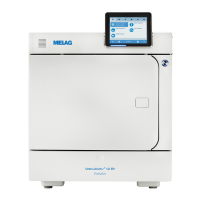
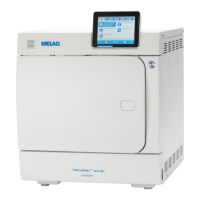
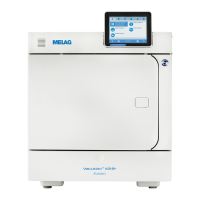
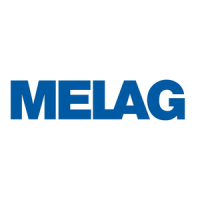
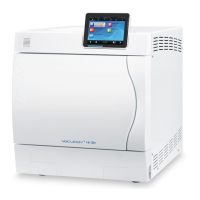
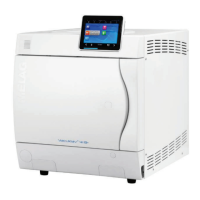
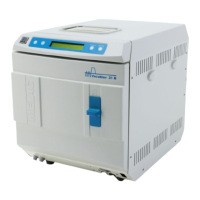
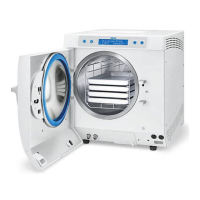
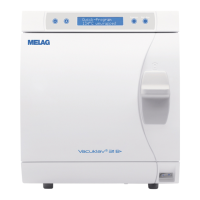
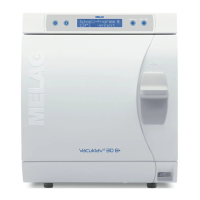
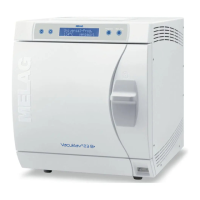

